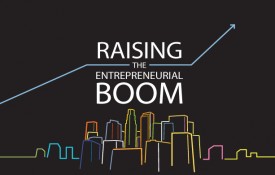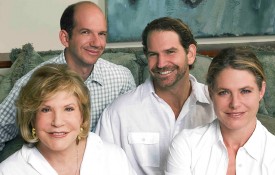Even before we had our first confirmed case of COVID-19 on the ground, we were advising employees to take their laptops and other equipment home with them over the weekend in case things escalated suddenly. Our first mandatory WFH day was Friday, March 13, but for the two weeks leading up to that decision, our team was well informed and prepared for the possibility. We recently reopened our office, on July 13, which serves as a proper bookend to those challenging four months that took place between exiting the office and returning to it.

SquareFoot’s own office space in New York.
Over these past months, I’ve been impressed with the resilience of my team. We never hired for or planned for working during a pandemic, yet everyone has stepped up and figured out how to not only do their roles, but also to find ways to advance the company’s mission in the process. Most critically, during those first weeks when the health scare was so prominent, we couldn’t lead office tours for clients. Still, we wanted to stay in close contact with them. So, our brokerage team shifted gears to establish themselves as trusted advisers to assist people—not just existing clients—who had questions about their office leases. Our team reviewed roughly 100 leases on behalf of others, and we provided insight and information for business owners and operators.
By late April, interest and inquiries through our platform had been restored to regular levels. In the interim, we offered what we could by way of virtual tours. Physical office tours only came back with Phase 3 of the reopening, in late June, so we had to wait patiently for the right time to resume that critical piece of what we offer.
When it comes to responses from our clients during the last several months, it has really depended on the type of company we’re dealing with. Some of them have memory of other downturns in the market. Others at younger companies turned to us for guidance and direction. The commonality among all of our clients is that, in March and into April, their office spaces weren’t their primary concerns. They wanted to reassure their teams, deal with the larger issues at play, check in on their own families, and devise plans to get through the toughest times. We were available to anyone who reached out directly, however we knew that those months were confusing and challenging for many of us and checking in about their office space needs wasn’t the priority.
They knew that, when the time was right, we’d be there and represent them well. After things stabilized a bit, and the worst weeks had passed, clients began to think again about what the next steps might be for restoring their spaces. By then, our team had done the necessary research to prepare for those conversations. Most of our clients are not experts in real estate, and they turn to us for counsel. We were ready to have those difficult discussions and lay out their options.
This industry was already headed in the direction of flexibility; the pandemic merely accelerated that change. Right now, landlords are fearful that some companies may not come back to the office at all, and those that do might look to downsize for fewer employees occupying at once. Last year, months before the pandemic was a serious threat for the U.S., we announced our Series B financing, which I had pitched and pledged to investors around the concept of flexibility. We purchased PivotDesk and launched FLEX, each their own version of flexible office space solutions, well ahead of COVID-19’s arrival. So, we haven’t had to change the game plan, we’ve just tightened it up and consolidated some of our ambition for the year in hopes of driving home even more the idea of flexibility being the future. What’s different now is not our approach—it’s that the world is talking about the future of office spaces in the same fashion that we were a year or more ago.

The company specializes in helping businesses find their best space and right lease.
My primary focus this year has been making sure that my team is well taken care of and that they feel supported. In April, as we spoke to them about the weight of this situation, we quickly realized that people needed a break. So we instituted a company policy that every other Friday would be a vacation day. We’d squeeze 10 days of work into nine days. That company policy remains in place through September, and I hope it continues. It sends the right message to everyone that we recognize there’s a whole lot more going on in people’s lives than just work. As a first-time dad to a son born this past spring, it’s given me quality time, too, to spend with my family. I don’t think under usual circumstances I would have taken this much time for paternity leave.
People want flexibility, in terms of when and where they can work but also in terms of the leases they are willing to sign.
It’s through that same lens that we approach conversations with our clients. We have always promoted that business leaders think deliberately and intentionally about the vibe they hope for from their office spaces. That is usually determined by commitments to company culture. We can help you choose the right space and envision it to match the flow and feel you aspire to inject. That’s not something a brokerage firm can lead; it comes authentically from the executives at the company. The way I see this going, we’ll have a number of companies land on a hybrid model, with some people coming in some of the time. It’s important for people to choose the right spaces to convey the messages they want. What’s changed now is that business owners are serious about giving people more options for where and when they work. That’s a good thing for employees for sure, and I also believe it’ll be a good thing for businesses overall.
Many companies will find themselves overextended by way of office space in the coming months, with a portion of, but not all, their employees returning to work. Subleases are the name of the game at the moment. The sublease market emerges always during down times, when people are retracting or rethinking their allotted space. For those who don’t have, say, a full floor to sublease, rather only a few desks, they can work with us via PivotDesk, which is like Airbnb for office space, and they can charge a smaller company for sharing the space with them for a defined period of time.
People want flexibility, in terms of when and where they can work but also in terms of the leases they are willing to sign. Nobody wants to be burdened at this time with a five-plus-year lease. Landlords are accommodating people more than ever to entice them to sign on, even if that means shorter terms than they’d have offered otherwise. That also ties into what I envision not coming back: the stronghold that landlords used to have on their spaces, many refusing to budge on or negotiate with or rethink what they wanted from their tenants. Today’s businesses won’t tolerate being pushed around by a traditional model and one-sided system. We’re fixing those relationships to make them more equitable and longer lasting.
Broadly, I’m bullish on the commercial real estate market. Some people may have been able to work well from home some of the time, but I haven’t seen enough evidence yet pointing to the death of the office. In fact, I’ve heard more conversations in the other direction. For a few months, the novelty of it all was working, especially for those who had been pushing their managers to adjust their practices and expectations. However, as these months have rolled on, the gaps and cracks have started to show within every company, I believe, and it’s time to take seriously the prospect of getting the team back together again. Zoom and Slack are great pieces of technology, however they do not replace company culture and cohesion.
For skyscrapers, I don’t imagine them changing much other than appealing to a wider swath of clients. If their typical client these days takes up a full floor, they might have to reimagine what that floor could look like for four or five different companies with pieces of it. Rebuilding those spaces could be labor intensive and expensive, yet it could appeal to what business owners will be looking for going forward: less space that goes further.

SquareFoot’s New York City headquarters.
What works for our clients, in my experience, is not different now than it was a year ago. They want to make sure that their investments in office spaces pay off in helping their business thrive. Office spaces have a direct tie to recruiting, for example. We haven’t even scratched the surface yet on whether ditching the office will or won’t appeal to competitive candidates. If I had to guess, it’ll turn away more people than it attracts. Most people want to get to know their colleagues in person, even if they do the bulk of their work while seated elsewhere.
I advise executives to take seriously the type of company they are looking to build and make sure that their physical footprint mirrors the values and vision that they hold dear. We’ve done 1,300 deals, and no two of them are precisely the same. Elements of office spaces can overlap, and wisdom can be borrowed. Yet, ultimately, it’s the chosen flavor of the company that is modeled in the hallways, with the color of the walls, and especially by the welfare of its constituents.













































